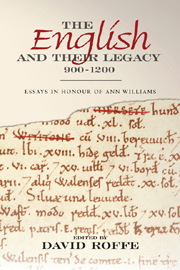Book contents
- Frontmatter
- Contents
- Figures and Tables
- Dedication
- Preface
- Contributors
- Abbreviations
- Ann Williams: a Personal Appreciation
- Life-writing and the Anglo-Saxons
- Meet the Swarts: Tracing a Thegnly Family in Late Anglo-Saxon England
- The Moneyers of Kent in the Long Eleventh Century
- Master Wace: a cross-Channel Prosopographer for the Twelfth Century?
- From Minster to Manor: the Early History of Bredon
- Eadulfingtun, Edmonton, and their Contexts
- The Family of Wulfric Spott: an Anglo-Saxon Mercian Marcher Dynasty?
- The Burial of King Æthelred the Unready at St Paul's
- Eustace II of Boulogne, the Crises of 1051–2 and the English Coinage
- Through the Eye of the Needle: Stigand, the Bayeux Tapestry and the Beginnings of the Historia Anglorum
- Robert of Torigni and the Historia Anglorum
- Invoking Earl Waltheof
- Hidden Lives: English Lords in post-Conquest Lincolnshire and Beyond
- Lordship and Lunching: Interpretations of Eating and Food in the Anglo-Norman World, 1050–1200, with Reference to the Bayeux Tapestry
- The Exchequer Cloth, c. 1176–1832: the Calculator, the Game of Chess, and the Process of Photozincography
- Ann Williams: a Bibliography 1969–2011
- Index
- Tabula Gratuloria
From Minster to Manor: the Early History of Bredon
Published online by Cambridge University Press: 05 April 2013
- Frontmatter
- Contents
- Figures and Tables
- Dedication
- Preface
- Contributors
- Abbreviations
- Ann Williams: a Personal Appreciation
- Life-writing and the Anglo-Saxons
- Meet the Swarts: Tracing a Thegnly Family in Late Anglo-Saxon England
- The Moneyers of Kent in the Long Eleventh Century
- Master Wace: a cross-Channel Prosopographer for the Twelfth Century?
- From Minster to Manor: the Early History of Bredon
- Eadulfingtun, Edmonton, and their Contexts
- The Family of Wulfric Spott: an Anglo-Saxon Mercian Marcher Dynasty?
- The Burial of King Æthelred the Unready at St Paul's
- Eustace II of Boulogne, the Crises of 1051–2 and the English Coinage
- Through the Eye of the Needle: Stigand, the Bayeux Tapestry and the Beginnings of the Historia Anglorum
- Robert of Torigni and the Historia Anglorum
- Invoking Earl Waltheof
- Hidden Lives: English Lords in post-Conquest Lincolnshire and Beyond
- Lordship and Lunching: Interpretations of Eating and Food in the Anglo-Norman World, 1050–1200, with Reference to the Bayeux Tapestry
- The Exchequer Cloth, c. 1176–1832: the Calculator, the Game of Chess, and the Process of Photozincography
- Ann Williams: a Bibliography 1969–2011
- Index
- Tabula Gratuloria
Summary
The purpose of this paper is to chart the early history of Bredon from monastery to episcopal manor between the eighth and early twelfth centuries. The village of Bredon lies at the base of Bredon Hill near the Worcestershire/Gloucestershire border on the river Avon, three and a half miles from Tewkesbury. The modern parish includes the hamlets of Kinsham, Westmancote, Mitton and Bredon's Norton. Cutsdean was part of the parish until transferred to Gloucestershire in 1912. The association of these outliers with Bredon can be traced back centuries. All but Kinsham were named in Domesday Book and belonged to the bishop of Worcester's manor of Bredon assessed at 35 hides. The name ‘Bredon’ is a testament to a long history of human settlement, being a compound of the British bre and the OE dūn, both meaning ‘hill’, and thus, like New York, so good they named it twice!
The settlement was long associated with the bishopric of Worcester. It was Ann who first alerted me to the rich archive of the see and in particular London, BL, MS Cotton Tiberius A.xiii, which incorporates the Liber Wigorniensis (LW) (folios 1–118) and Hemming's cartulary (Codicellus) (folios 119–200). From internal evidence the compilation of the LW is dated between 996 and 1016 and the Codicellus to the five-month period between the death of St Wulfstan on 20 January 1095 and the consecration of his successor, Samson. In addition, there are fragments of another cartulary produced during the episcopacy of St Wulfstan (1062 x 1095).
- Type
- Chapter
- Information
- The English and their Legacy, 900–1200Essays in Honour of Ann Williams, pp. 79 - 94Publisher: Boydell & BrewerPrint publication year: 2012



